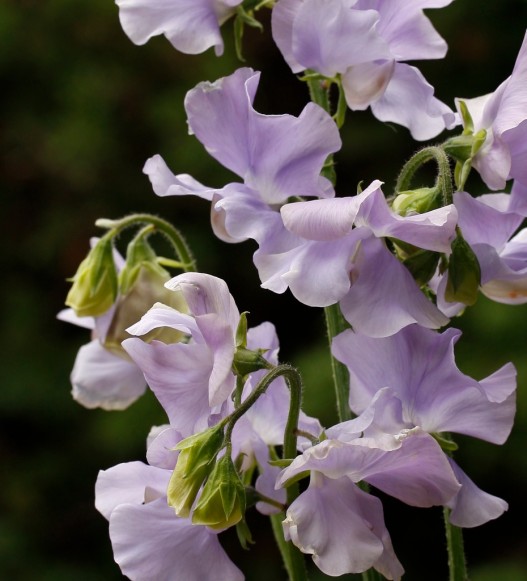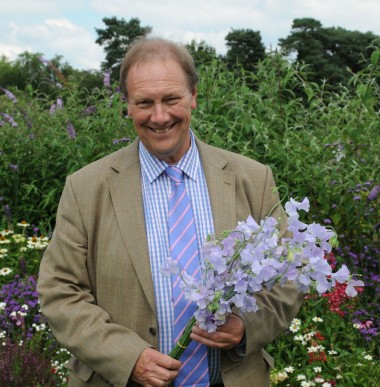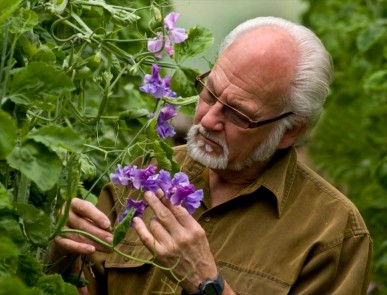I’ve never been any good at growing sweet peas, so I asked my friend to write about them for me.
Article by Anne-Marie Strickland and photos kindly supplied by Dr Keith Hammett
RELAX. You don’t have to do what the Vatican says, therefore St Patrick can safely be ignored on the matter of when to plant your sweet peas. And 2013 is definitely the year of the sweet pea, according to NZ breeder Dr Keith Hammett, who recently visited Melbourne.
Never mind that 17 March has come and gone. It’s a brave new world for lovers of the sweet pea’s inimitable scent, beauty and profusion. And much of that is due to a century-old misunderstanding that had we Aussies rushing to plant our sweet peas by Saint Patrick’s Day. You can sow them in Spring for a Summer display, and according to Diggers’ field trials they will stand up to our hot summers. Tim Sansom, the company’s CEO (Horticulture) says that with good planning, you can have sweet peas flowering for nine months of the year. To achieve this, you’ll need to sow short-day varieties in March, May, September and December; and sow long-day varieties in March, September and November.
And if you’re heading to the Chelsea Flower Show, keep your eye out for a display of Keith Hammett’s newest award-winning bloom, Chelsea Centenary. We’ve been a bit bored with ordinary sweet peas in Australia, but this new range of blooms is stunningly beautiful, smell good, last well in the vase and have good long stems. How do I know? I snaffled some early seeds, Tim Sansom at Digger’s has been running trials, and Keith Hammett says so.
Sweet peas are made of this …….
Sweet peas hate copper and acid soils. If you’re gardening on mere dirty sand as I am, dig in as much compost and organic matter as you can find (sheep manure from The Gift of the Wooly Beast did very well for me last year) and water it in before you plant. If your soil is already acid, add lime or grow in pots. Keep seeds damp till germination. I like to use those cardboard inner tubes from paper-towel rolls to train the roots straight down. Direct sowing in a sunny spot works fine, and the cardboard will rot in plenty of time. The more water they get when it’s warm, the happier they will be. Keep snails away (in this case, NOT with copper bands, although they are very entertaining to watch – see Penny’s video on this site). Try wood ash and beer traps. Pick the flowers constantly so the plant doesn’t go to seed. The flowers might look a tad ethereal, but they’re as tough as old boots.
Australian cottage gardeners still have that contrarian streak they brought with them on the coffin ships to the colonies, and still love their scented sweet peas but it seems some English gardeners don’t agree. “In general exhibitors in Britain only like single colours, and just four flowers per stem. Scent is not a criterion that is taken into account when judging sweet peas on the show bench,” Keith Hammett says. “But scent is certainly the attribute that people consider most important in the sweet pea. Because I have gone back to ancestral types, most of my cultivars have a good scent. ‘High Scent’ is considered to be the world standard for scent, but I have another called ‘More Scent’, which people who have not yet lost their sense of smell tell me is more strongly scented.” (He means smokers.)
Keith says the sweet pea differs from many garden plants in that it is self-pollinating, with each flower having been pollinated before it is open. “The species Lathyrus odoratus is very resistant to hybridising, even with close relatives. This means that variation has only come about by mutation, not by introducing traits from other species.”
Having made a mutation to Antipodean horticulture and cracked Chelsea, Keith will now return to his “yellow period”. “I have retraced my steps and am trying to pick up on getting yellow pigment better expressed,” he says. “About 25 years ago a previously unknown species, L. belinensis, was discovered in Turkey. I was able to obtain seed and in association with cytogeneticist, Professor Brian Murray of Auckland University, made a cross with the intention of introducing yellow pigment into the sweet pea. This aim is still to be realised. But the introduction of genes from L. belinensis has led to greatly enhanced contrast between Standard and Wing petals in my reverse bicolour types. ‘Erewhon’ is the most notable of these. In ‘Blue Shift’ the blooms open as a dilute maroon and violet, but each day as the bloom ages intense blue and ultramarine colours develop. Distinct vein pigmentation, called marbling, has been developed. The first of this type to be released was ‘Blue Vein’. This year ‘Porlock’ is being introduced where the veins are a dark maroon with the ground colour crimson.”
Next year might bring mellow yellow (or Dr Keith Hammett on another Australian promotional tour). So don’t worry about having got your sweet peas in right on time: they’ll still be fine. It’s a miracle.
Hammett sweet pea seeds can be obtained from Diggers and Mr Fothergills.



